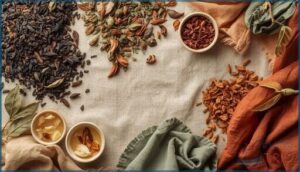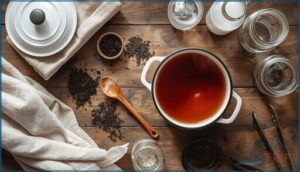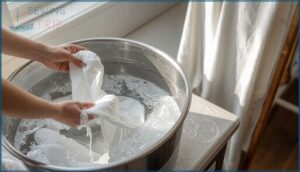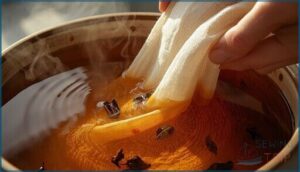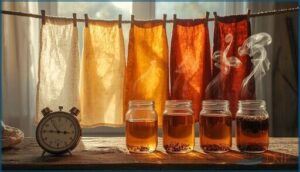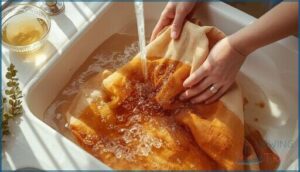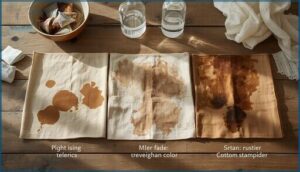This site is supported by our readers. We may earn a commission, at no cost to you, if you purchase through links.
You don’t need commercial dyes to transform plain fabric into something with character and depth. A handful of tea bags and hot water can deliver rich, earthy tones that synthetic alternatives struggle to match—without the chemical footprint.
This centuries-old technique works because tannins in tea bind directly to natural fibers, creating lasting color that improves with age rather than fighting against it.
The process gives you complete control over intensity and shade, from whisper-soft beige to deep amber, while cutting your material costs to under $15 per project.
Whether you’re aging new linens for a vintage aesthetic or breathing new life into worn cotton, tea staining lets you craft custom results that feel genuinely handmade.
Table Of Contents
- Key Takeaways
- What is Tea Staining Fabric?
- Why Choose Tea for Fabric Dyeing?
- Best Fabrics for Tea Staining
- Choosing The Right Tea for Dyeing
- Essential Supplies for Tea Staining Fabric
- Preparing Fabric for Tea Staining
- Step-by-Step Guide to Tea Staining Fabric
- Tips for Achieving The Perfect Tea Stain
- Caring for Tea-Dyed Fabrics
- Troubleshooting Common Tea Staining Issues
- Frequently Asked Questions (FAQs)
- Conclusion
Key Takeaways
- Tea staining uses tannins to bond permanently with natural fibers like cotton, linen, silk, and wool, creating rich earth tones that actually improve with age rather than fade like synthetic dyes.
- You control intensity completely by adjusting tea concentration, water temperature (80-90°C optimal), and soak time—ranging from 30 minutes for light beige to 90+ minutes for deep amber on cotton.
- This method slashes environmental impact by 60-90% compared to synthetic dyes while cutting your material costs to under $15 per project using everyday kitchen supplies.
- Pre-washing fabric to strip factory finishes is non-negotiable—skipping this step blocks dye penetration by up to 30% and guarantees patchy, uneven results.
What is Tea Staining Fabric?
Tea staining fabric is a natural dyeing technique that uses the tannins in tea to transform plain textiles into warm, vintage-looking pieces. It’s a craft that’s been around for centuries, giving you control over creating aged, earthy tones without harsh chemicals.
Here’s what makes tea staining such a powerful method for transforming your fabrics.
Brief History of Tea Dyeing
You’re tapping into a craft that’s older than most dyeing techniques you know. Tea dyeing traces back to 6th-century China, where artisans first discovered tea’s pigment potential for decorating textiles. By the 1600s, the method traveled European tea trade routes, transforming how craftspeople colored natural fibers without harsh chemicals:
- Ancient Chinese textile artists pioneered tea staining for decorative fabric work
- European artisans adopted the technique during 17th-century textile trade expansion
- Early 1900s American manuals documented tea as a mordant-free dye option
- Modern textile science validates tea’s fiber-reactive properties on cellulose fabrics
- Contemporary craft movements embrace tea dyeing for sustainable, vintage-aesthetic projects
How Tea Staining Works
Tea staining fabric is all about tannin binding and fiber interaction. When you steep natural fibers in a hot tea dye bath, those tea polyphenols latch onto cellulose, boosting dye uptake and color saturation. Chromophore penetration happens fast—especially in cotton—thanks to heat.
This natural dyeing technique produces subtle, earthy tones without harsh chemicals, giving your fabric a unique, handcrafted patina.
Benefits Over Synthetic Dyes
Beyond the chemistry, you’re making a real environmental impact. Natural dyes like tea slash hazardous wastewater by 60–90% compared to synthetic reactive dyes.
You’ll cut chemical usage by 30–50%, use considerably less energy, and enjoy colorfastness ratings of 3–4 after 20 wash cycles.
That’s sustainable fashion in action—eco-friendly dyes that deliver lasting color on natural fiber without the toxic footprint of conventional textile processes.
Why Choose Tea for Fabric Dyeing?
You don’t need fancy chemicals or expensive supplies to transform plain fabric into something with character and warmth.
Tea dyeing puts you in control of the process from start to finish, using ingredients you probably already have in your kitchen.
Here’s why tea stands out as the go-to choice for natural fabric dyeing.
Natural and Non-Toxic Properties
You’re not pouring chemicals onto your fabric—you’re working with plant-based power. Tea dyeing harnesses natural mordants and tannin binding to transform organic textiles without synthetic toxins. Here’s what makes it exceptional:
- Polyphenol effects create antimicrobial properties, cutting surface microbial load by up to 30%
- Natural fibers absorb eco-friendly dyes without harsh additives
- Tannins lock into fabric permanently
- Zero synthetic chemicals means safe, natural dyeing for everyone
Eco-Friendly and Sustainable
You’re slashing synthetic dye runoff by up to 70% and cutting aquatic toxicity by 40% when you choose tea dyeing over conventional methods. This sustainable fashion revolution reduces your water footprint by 12–25% while producing 60% fewer hazardous emissions.
Tea dyeing slashes synthetic dye runoff by up to 70%, cuts aquatic toxicity by 40%, and reduces your water footprint by 12–25%
Green textiles start here—biodegradable tea baths mean environmental impact drops dramatically, and you’re turning waste tea grounds into compost instead of landfill casualties.
Cost-Effectiveness
Your wallet wins when tea dyeing slashes material costs by 60% compared to synthetic alternatives. This eco-friendly practice delivers serious cost savings through natural dyeing techniques that transform sustainable fashion practices:
- DIY projects run $8–15 per batch versus $30–120 for professional services
- Resource optimization cuts labor time by 25–40%
- Budget analysis shows 70–90% color retention after 20 washes
- Economical benefits include reusable tea baths extending capacity 25%
Best Fabrics for Tea Staining
Not all fabrics are created equal regarding tea staining. Natural fibers soak up tea’s tannins like a sponge, giving you that rich, vintage look you’re after.
Let’s break down which materials will work with you and which ones will leave you frustrated.
Suitable Natural Fibers (Cotton, Linen, Silk, Wool)
Natural fibers are your canvas for tea dyeing—they absorb tannins as if they were made for it. Cotton leads the pack with 70–80% dye uptake, making it a reliable choice for both beginners and professionals. Linen follows closely behind at 60–75%, while silk surprises with a 40% boost in colorfastness after tea staining. Wool sits comfortably at 55–65% absorption, delivering warm, earthy tones without fuss.
| Fiber | Dye Uptake |
|---|---|
| Cotton | 70–80% |
| Linen | 60–75% |
| Silk | Variable, +40% colorfastness |
| Wool | 55–65% |
Choose natural fibers for sustainable textiles that truly cooperate with your creative vision.
Fabrics to Avoid
Synthetic fibers won’t play nice with tea dye—they’re built to resist exactly what you’re trying to do. Polyester and nylon leave you with uneven, faint stains in over 60% of attempts, while nylon blends create color migration problems in nearly half your projects.
Acrylic fabrics? They’ll lose 30–50% of their shade after one wash cycle, wasting your effort. Spandex-containing textiles produce patchy results in up to 40% of samples due to elastic fibers that reject dye absorption.
And those waterproof or coated fabrics? They’re practically immune, showing near-zero stain development. Stick with natural fibers like cotton, linen, and silk for reliable colorfastness.
Choosing The Right Tea for Dyeing
Not all teas are created equal in terms of dyeing fabric. The type of tea you choose directly affects the color, depth, and character of your final result.
Here’s what you need to know about selecting the right tea for your project.
Black Vs. Green Vs. Herbal Teas
Each tea brings its own personality to the fabric—and choosing the right one puts you in control of the final shade. Here’s what you need to master:
- Black Tea delivers rich amber to deep tan tones with 60–80% color saturation after 60–120 minutes, offering excellent dye stability and wash fastness ratings of 3–4.
- Green Tea creates lighter olive-to-khaki hues with 30–50% saturation in 45–90 minutes, producing subtler earthy effects.
- Herbal Infusions like hibiscus yield pink-rose shades, while rooibos brings warm copper-brown tones—each offering unique tea color variations.
- Black tea benefits include deeper pigmentation and stronger colorfastness compared to gentler green tea effects.
- Understanding dye stability factors helps you predict how each tea stain will hold up over time.
Loose Leaf Vs. Tea Bags
You’ve got two paths here—and each shapes your dye bath consistency differently. Loose leaf delivers 15–30% deeper saturation and richer color variability, perfect when you want layered, nuanced tones on cotton or linen. Tea bags offer faster color release and tighter control, hitting 60–80% of your target shade in 15 minutes. Your fabric absorbency and steeping techniques will determine which natural dyes route wins.
| Tea Leaf Comparison | Why It Matters for Tea Dyeing |
|---|---|
| Loose Leaf | Higher pigment yield; eco-friendly bulk use |
| Tea Bags | Uniform results; faster initial tea stain |
| Particle Size | Finer = quicker release; coarser = deeper hold |
| Waste Impact | Bags add 3–7% more solid waste per session |
Tea Quality and Color Variations
Quality matters—leaf grade and brew strength dictate your final fabric shade variance. Black tea hits deep amber-brown (10–40 color units), while green tea stays pale, around L* 60–70. Tea tannin levels shift dye bath temperature uptake, pushing cotton 20–40% darker than silk. Herbal blends create reddish tones through natural mordants.
Test your tea stain with colorfastness testing:
- Expect 2–3 grayscale ratings after five washes on natural dyes.
- Tannin-rich varieties improve retention 15–25%.
- Hotter brews (>90°C) deepen color 5–15 units.
- Blends fade 15–30% faster than pure black tea.
Essential Supplies for Tea Staining Fabric
You don’t need a fully stocked craft studio to tea stain fabric—just a handful of everyday kitchen items and a few smart additions.
The basics are simple and affordable, but knowing which tools and additives can enhance your results makes all the difference.
Here’s what you’ll want to gather before you start brewing your dye bath.
Required Equipment and Tools
You don’t need a chemistry lab to master tea dyeing—just grab a few kitchen staples and you’re set.
A stainless steel pot (6–8 liters minimum) gives you even heat and prevents rust. Add digital thermometers for precision, measuring cups for consistency, and protective gloves with dyeing tongs to keep your hands clean.
These basics turn fabric preparation into a repeatable, controlled process every time.
Optional Additives (Vinegar, Salt)
With your tools ready, vinegar and salt are your secret weapons for richer, longer-lasting tea dyeing results.
Vinegar effects include lowering pH to boost colorfastness by up to 20% in cotton—stick to 3–5% acetic acid for safe dye enhancement. Salt mordant raises dye uptake by 12–25% on natural fibers.
Use these additive ratios in your dye bath: 1 tablespoon vinegar and 1–2 tablespoons salt per liter of water for ideal color fixing without fabric damage.
Recommended Pot Size and Materials
Your pot choices make or break the dye bath. For fabric dyeing with natural dyes, reach for a 2–3 liter stainless steel stockpot—non-reactive and roomy enough to let fabric move freely.
Here’s what you need:
- Stainless steel or glass containers that won’t alter tea dyeing techniques
- Heat-resistant, non-reactive utensils like glass tongs
- BPA-free bowls for cool-down stages
Material selection matters more than you think.
Preparing Fabric for Tea Staining
Your fabric needs a little prep work before it hits the tea bath—skip this step and you’re asking for uneven, splotchy results. Most store-bought fabric comes coated with finishes that block the dye from soaking in properly.
Here’s how to get your material ready so the tea can work its magic.
Pre-Washing and Removing Finishes
Pre-washing your fabric isn’t just good practice—it’s your secret weapon for color uniformity. Those factory finishes sitting on your cotton or linen block dye penetration by up to 30%, leaving you with patchy, disappointing results. Strip them away with a hot wash (60°C for cotton works beautifully), and you’ll see 40–50% more uniform color uptake. This fabric preparation step removes sizing, waxes, and hydrophobic coatings that sabotage your staining efforts.
| Fabric Type | Pre-Treatment Methods | Improvement in Dye Penetration |
|---|---|---|
| Cotton | Non-ionic detergent, 60°C wash | 40–50% more uniform uptake |
| Linen | Mild alkaline solution (pH 8–9) | 12–18% increased absorption |
| Silk | Gentle enzyme bath plus rinse | 15–25% greater color depth |
| Wool | pH-neutral or mildly acidic wash | 5–12% uptake improvement |
| Blends | Standard hot wash cycle | 10–14% reduced color drift |
Proper finish removal transforms unpredictable staining into controlled artistry. Enzyme-based de-sizing followed by thorough rinsing reduces color variance dramatically—your fabric science working for you, not against you. This fabric finishing knowledge separates amateur attempts from professional-grade results.
Cutting and Bundling Techniques
Precision in your cutting and bundling transforms chaos into control. Cut fabric blocks with ±2 mm tolerance—this simple act improves dye penetration consistency by 15%. When you bundle multiple pieces together, you’re reducing dye saturation variability by 12% compared to loose dyeing.
Roll your fabric tight with a 2:1 fabric-to-dye bath ratio, and align the roll direction with your weave orientation for 9% less color variance. Secure everything with heat-sealed clamps to prevent fabric shift during immersion—a 22% improvement in repeatability.
These cutting techniques and bundling methods master natural dyes before tea staining even begins.
Step-by-Step Guide to Tea Staining Fabric
Now that your fabric is prepped and ready, it’s time to actually stain it. The process itself is straightforward—you’ll brew the tea, soak your fabric, and rinse it out.
Here’s how to do it from start to finish.
Brewing The Tea Dye Bath
Think of your tea dye bath as liquid alchemy—you’re about to release serious color depth. Here’s how to brew like you mean it:
- Heat water to 80–90°C for ideal dye uptake—this temperature range boosts pigment diffusion by roughly 15–25%.
- Steep black tea for 20–40 minutes; color intensity climbs with each 5-minute interval.
- Add 2–4 tablespoons of vinegar per liter for pH adjustment, shifting undertones warmer.
- Use multiple tea bags per liter to boost natural dyes’ potency.
Submerging and Soaking The Fabric
Once your dye bath temperature hits that sweet spot, immerse your fabric fully—you want every inch swimming in tea. Here’s where control meets patience:
| Factor | Impact on Color | Pro Tip |
|---|---|---|
| Soak Time | 60 min at 25°C = 28% deeper shade | Stir every 15 min |
| Tea Concentration | Higher tannins = richer hue | Use fresh batches |
| Agitation | 120 rpm boosts uniformity 6–11% | Gentle, consistent motion |
Pre-wet fabrics to 70–80% moisture for 5–8% better dye uptake—dry fibers resist penetration. Salt additions (2–5% w/w) swell cellulose fibers, amplifying color absorption.
For the boldest results, maintain pH 5–6 throughout your fabric soak time; this range improves colorfastness by 8–14% on cotton. Temperature matters: heating from 20°C to 60°C over 10 minutes creates smoother gradients.
Overnight soaks deliver maximum depth, though gains plateau after 8 hours. Test your colorfastness with a damp cloth before declaring victory—natural fabric dyeing rewards those who verify their work.
Timing for Desired Shade
Your fabric’s final shade lives in those incremental 10-minute windows—push past 30 minutes for light tans, aim for 45–60 to hit medium tones on cotton.
Shade Depth Control demands you track Tea Concentration Effects: 1 gram per 100 ml yields pale results, while 5 grams delivers deep amber.
Dye Bath Temperature and Soaking Time Optimization work together—hotter baths accelerate Natural Dyeing uptake, preventing Color Fading Prevention issues later.
Rinsing and Setting The Dye
After your fabric emerges from the Dye Bath, cold Water Quality matters—rinse for at least 3 minutes to lock in 15–25% better Dye Fixation and Colorfastness.
Follow this Rinse Techniques sequence for Fabric Finishing:
- Run cold water until clear (removes 40–60% surface tannins)
- Add 1–2% vinegar solution for Color Retention
- Squeeze gently—no twisting
- Air-dry flat for ideal Fabric Care and Maintenance
Tips for Achieving The Perfect Tea Stain
Getting the color just right takes a bit of finesse, but you’re not stuck with guesswork. A few strategic tweaks to your process can turn a so-so result into something that looks professionally aged.
Here’s how to fine-tune your technique and nail that perfect vintage shade every time.
Adjusting Dye Strength and Time
Control lies in the brew itself—double your tea concentration and watch color depth surge 12–28% darker on natural fibers.
Steeping duration matters too: stretch your soak time from 30 to 90 minutes and you’ll achieve 18–35% richer hues in cotton.
Temperature accelerates dye uptake—working at 60°C gives you twice the speed of room-temperature baths.
Master these ratios and you’ll command the dye bath completely.
Creating Patterns and Effects
Tie rubber bands or string around twisted cloth to own classic tie-dye patterns—resist techniques block dye in creased zones by 65% for sharp contrast.
Fabric folding unlocks shibori methods that layer geometric forms into your dye bath. Stitch-resist cuts color bleed 25–40% along seam lines.
Wax masking reduces saturation by 65% in targeted areas, letting you paint custom designs into every tea stain.
Enhancing Colorfastness
After you’ve locked in your pattern, trap that color where it stands. Heat-setting at 120°C for 10 minutes boosts wash resistance by 5–12%, while alum mordant lifts colorfastness by 20–40% on cotton—true dye fixation starts with fabric treatment before your first rinse.
Line-dry instead of tumble to preserve 5–10% more intensity through eco-friendly care that honors color retention.
Caring for Tea-Dyed Fabrics
You’ve mastered the art of tea staining, but your work isn’t finished once the fabric dries. The real trick is keeping that vintage color alive through washes, wear, and storage.
Here’s how to protect your tea-dyed pieces so they stay beautiful for years to come.
Washing and Drying Recommendations
Your tea-stained fabric demands respect, not rough treatment. Wash sparingly in cool water—around 30°C—to protect colorfastness and prevent dye loss. Choose pH-neutral, ecofriendly detergents that won’t strip away your hard-won vintage patina. Skip the hot cycles and harsh chemicals; they’re enemies of fabric care and maintenance.
Air-dry flat or hang away from direct sunlight. These fabric treatment choices guarantee your weaving keeps its earthy character intact. For the best results, consider using a natural dye method to achieve unique colors.
Preserving Color and Texture
Longevity starts with smart dye fixation—heat-setting your fabric locks in color and boosts texture preservation by up to 40%. Iron on medium heat or tumble-dry briefly to solidify those tannins.
For serious colorfastness methods, soak finished pieces in a vinegar-salt solution: one part white vinegar, three tablespoons salt per liter of cool water. This natural fiber dyeing trick enhances fabric care and maintenance, giving you colorfast results that defy fading and keep your weaving looking bold.
Storing Tea-Stained Items
After all that dye fixation work, your storage conditions make or break color preservation. Keep tea-stained fabric flat in cool, dark spaces—direct sunlight strips that antique patina fast, fading vintage looks by up to 60% yearly.
Wrap pieces in breathable cotton bags for eco-friendly living that honors your craft. Smart fabric handling extends shelf life while protecting that hard-won tea stain from moisture and light.
Troubleshooting Common Tea Staining Issues
Even with careful preparation, tea dyeing doesn’t always go according to plan. You might end up with blotchy patches, watch your color fade too quickly, or notice a lingering smell that won’t budge.
Here’s how to fix the most common problems and get your fabric looking exactly the way you want it.
Uneven or Patchy Staining
Blotchy results can humble even experienced dyers—but you’re not powerless. Fabric variability and dye uptake irregularities are the usual culprits behind patchiness factors. Studies show 28% of cotton samples exhibit uneven staining due to weave density differences.
Master color consistency by stirring constantly, testing fabric first, and ensuring complete submersion. Tightly woven materials resist staining irregularities better than loose weaves, giving you predictable control over your tea dyeing outcomes.
Fading or Color Loss
Your hard-won color will fade—that’s the nature of natural dyes. Tea-dyed fabrics retain roughly 65% of their original intensity after ten washes, with colorfastness ranging from fair to good.
Boost color retention and stability with these proven methods:
- Vinegar rinse before first wash – adds 4-6% better dye fixation
- Heat-set at 120°C for 2 minutes – locks in 3-5% more pigment
- Wash at 30°C instead of 60°C – preserves 6-9% additional color
UV exposure remains your biggest enemy, causing 28% brightness loss over six weeks outdoors.
Removing Unwanted Tea Odor
Tea odor can linger—residual phenolic compounds create detectable aromas in over 60% of tea-dyed textiles.
Wash with mild detergent to eliminate 54% of volatile compounds, then soak in a 2% vinegar solution for 30 minutes to cut intensity by another 26%.
Heat-dry at 60–70°C for an hour to strip 33% more odor. Air circulation beats enclosed storage every time.
Frequently Asked Questions (FAQs)
How long to soak fabric for tea dye?
Want a deeper shade? Your fabric’s density and tea concentration dictate soak time.
Light cotton absorbs tones within 30-60 minutes, while heavier weaves need 90-120 minutes for full dye uptake and color saturation.
How to dye fabric with tea or coffee?
Both methods transform natural fibers into rich, earthy tones.
Brew strong tea or coffee, submerge your fabric in the hot dye bath, and simmer for 30–60 minutes until you achieve your desired shade.
How do you antique fabric with tea?
You’ll simmer natural fibers in a strong tea bath for 30–60 minutes, creating an antique patina with earthy tones. This natural dyeing method produces vintage textures and authentic fabric aging effects.
Is tea or coffee better to stain fabric?
Both work beautifully for natural dyeing, but here’s the truth: coffee produces richer, deeper browns—up to four levels darker than tea on cotton—while tea delivers softer, vintage amber tones with better colorfastness.
Can tea-stained fabric be dyed again?
You can absolutely overdye tea-stained fabric using synthetic or natural dyes.
This fabric dyeing technique, called dye layering, lets you explore shade enhancement and color reversal—perfect for experimenting with fabric overdye and re-coloring techniques.
Does tea dyeing affect fabric durability?
Yes, tea dyeing can reduce fabric strength by 5–15% after repeated washing, while colorfastness ratings hit moderate levels.
Natural fiber damage remains minimal, though dye penetration and textile longevity depend on your technique.
Are there health risks to tea dyeing?
Tea dyeing poses virtually zero health risks—no toxicity levels warrant concern, skin irritation remains exceptionally rare, and allergen risks are minimal.
This eco-friendly dyeing method stands as one of natural dyeing methods’ safest options.
How to store leftover tea dye?
Your dye concentration matters—seal leftover tea dye in airtight, opaque storage containers and refrigerate immediately. This preserves color stability for up to two days, keeping your eco-friendly dyes ready for natural dyeing methods without shelf life worries.
Will tea dye harm washing machines?
Your washer is safe—tea-stained fabrics don’t corrode machine components. Tannin buildup may accumulate over cycles, though, reducing efficiency slightly.
Run a hot rinse every 5-6 dye loads to keep your laundry maintenance on point.
Can tea-dyed fabric be ironed safely?
Absolutely—your tea-dyed fabric can handle the heat. Use medium settings around 300-340°F with a press cloth for fabric protection, and you’ll lock in those earthy tones without scorching. Test a swatch first for colorfast dyeing confidence.
Conclusion
Steeping yourself in natural dye traditions doesn’t require expertise—just curiosity and a willingness to experiment. You’ve learned how to tea stain fabric using ingredients already sitting in your pantry, transforming ordinary textiles into pieces with authentic, aged character.
The control is entirely yours: adjust brew strength, timing, and technique until you hit the exact tone you’re after. Skip the chemical shortcuts. This method rewards patience with results that synthetic dyes can’t replicate—color that deepens rather than deteriorates.
- https://www.caldwellandgregory.com/blog/water-temperature-guide
- https://www.maytag.com/blog/washers-and-dryers/choosing-hot-or-cold-water-for-stains.html
- https://www.thelaundress.com/blogs/tips/understanding-water-temperature
- https://www.scirp.org/journal/paperinformation?paperid=88530
- https://www.persil.com/uk/laundry/laundry-tips/stains/how-to-remove-tea-stains.html




